Intensity (physics) facts for kids
In Physics, intensity can usually be understood as the strength of something like a beam of light. Intensity in general refers to the amount of light that is falling at a point. To figure out (i.e., compute) the exact intensity of a beam of light or a fire hose spraying water, we need to know how many units of light or water are coming to some area in some period of time. A factory might have an "intensity" of 100 cars per day delivered to the loading dock. A fire hose might have an intensity of 100 buckets of water per minute per open window of a certain size in a burning building.
Usually, when talking about intensity, you are talking about the amount of energy of particles or radiation per unit area. Since each particle spreads out from the source in a sphere, the area is measured as the surface area of this sphere, or  , where
, where  is the distance from the source to the observer.
is the distance from the source to the observer.
Alternative definitions
In photometry and radiometry intensity has a different meaning: it is the luminous or radiant power per unit solid angle. This can cause confusion in optics, where intensity can mean any of radiant intensity, luminous intensity or irradiance, depending on the background of the person using the term. Radiance is also sometimes called intensity, especially by astronomers and astrophysicists, and in heat transfer.
See also
 In Spanish: Intensidad (física) para niños
In Spanish: Intensidad (física) para niños
- Field strength
- Sound intensity
- Magnitude (astronomy)


